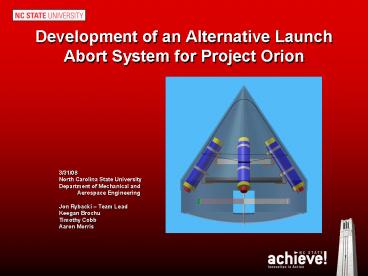Development of an Alternative Launch Abort System for Project Orion - PowerPoint PPT Presentation
1 / 14
Title:
Development of an Alternative Launch Abort System for Project Orion
Description:
Develop proof-of concept design for a launch abort system by: ... The boast protective cover: Improves aerodynamic performance ... – PowerPoint PPT presentation
Number of Views:48
Avg rating:3.0/5.0
Title: Development of an Alternative Launch Abort System for Project Orion
1
Development of an Alternative Launch Abort System
for Project Orion
- 3/31/08
- North Carolina State University
- Department of Mechanical and
- Aerospace Engineering
- Jon Rybacki Team Lead
- Keegan Brochu
- Timothy Cobb
- Aaron Morris
2
Problem Statement
- Develop proof-of concept design for a launch
abort system by - Demonstrating launch pad abort tests
- Computationally simulating the dynamics of the
system
3
What is a Launch Abort System?
- Safe and reliable system
- Separates manned module from rocket stack
- Saves the lives of astronauts in case of
emergency - For Orion, NASA wants the LAS to have 10 15 g
acceleration for 2 sec
4
Flight Test Article
- Goals
- Design and build a FTA for a mock abort
- Conduct a minimum of 6 successful instrumented
tests - Mimic the Orion Launch Abort System
- Shape
- Density
- Moments of Inertia
- Thrust to weight ratio
5
Flight Test Article
6
What is a 6 Degree of Freedom Simulation?
- Independent motion in axial directions and
angular displacements - Fully realizes motion from any number of forces
on system - Based on Newtons Second Law of Motion
7
How the Simulation is being Used
- Design process decisions
- Streamer sizing
- Ejection charge delay timing
- Theorize motion of the system
- Compare simulated results to flight test data
from in article accelerometers
8
Simulation Run
Inertial Frame Displacements
- Random ignition timing rockets
- Maximum altitude 225 ft
- Maximum velocity 140 ft/s
- Flight time 11 s
200
100
Displacements (ft)
0
0
12
6
Time (s)
Body Frame Velocities
120
80
40
Velocities (ft/s)
0
0
6
12
Time (s)
9
Pre-launch Tests
- Rocket tests
- Thrust profiles
- Ignition timings
- Drop tests
- Size parachutes
- Test durability of the shell
- Strapped Down Launch
- Releasing mechanism
- Guide rod interaction
- Nose cone seperation
10
Flight Tests
- Successful abort criteria
- Streamer deployment
- Stable flight path
- Quickly leaves
- launch area
- Technical difficulties
- Non-simultaneous
- ignitions
- Misfiring of rocket
- Goals
- Observe how
- streamers affect flight
- Compare telemetry to simulation
11
Flight Test Video
12
Moving Towards a Full Scale Model
- Hypergolic rockets to improve ignition timing
issues - Explosive bolts would ensure all rockets have
fired - Small control tower to provide active controls
- Similar to Shuttle Reaction Control System (RCS)
- Gimbaled nozzles to provide initial maneuvering
- Similar to Space Shuttle Main Engines (SSME)
- Streamer is a simplistic way for providing
passive control
13
Results and Conclusions
- The boast protective cover
- Improves aerodynamic performance
- Houses abort rockets with no increase in diameter
of launch vehicle - Streamer
- Increases stability
- Increases drag
- Future of the project
14
Questions





























